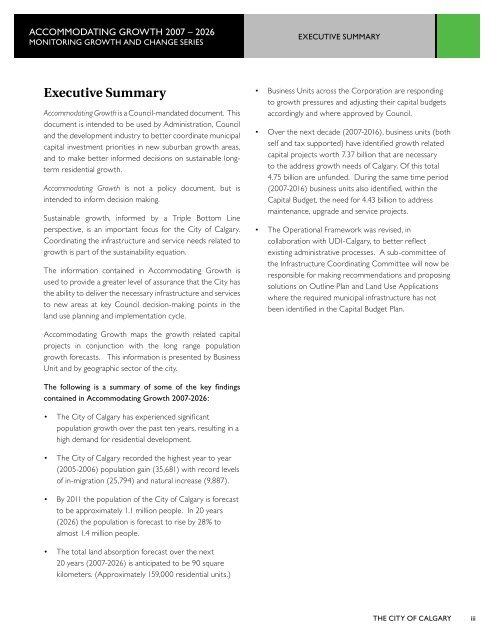Accommodating_growth_one
Accommodating_growth_one
Accommodating_growth_one
You also want an ePaper? Increase the reach of your titles
YUMPU automatically turns print PDFs into web optimized ePapers that Google loves.
accommodating <strong>growth</strong> 2007 – 2026<br />
monitoring <strong>growth</strong> and change series<br />
executive summary<br />
Executive Summary<br />
<strong>Accommodating</strong> Growth is a Council-mandated document. This<br />
document is intended to be used by Administration, Council<br />
and the development industry to better coordinate municipal<br />
capital investment priorities in new suburban <strong>growth</strong> areas,<br />
and to make better informed decisions on sustainable longterm<br />
residential <strong>growth</strong>.<br />
<strong>Accommodating</strong> Growth is not a policy document, but is<br />
intended to inform decision making.<br />
Sustainable <strong>growth</strong>, informed by a Triple Bottom Line<br />
perspective, is an important focus for the City of Calgary.<br />
Coordinating the infrastructure and service needs related to<br />
<strong>growth</strong> is part of the sustainability equation.<br />
The information contained in <strong>Accommodating</strong> Growth is<br />
used to provide a greater level of assurance that the City has<br />
the ability to deliver the necessary infrastructure and services<br />
to new areas at key Council decision-making points in the<br />
land use planning and implementation cycle.<br />
• Business Units across the Corporation are responding<br />
to <strong>growth</strong> pressures and adjusting their capital budgets<br />
accordingly and where approved by Council.<br />
• Over the next decade (2007-2016), business units (both<br />
self and tax supported) have identified <strong>growth</strong> related<br />
capital projects worth 7.37 billion that are necessary<br />
to the address <strong>growth</strong> needs of Calgary. Of this total<br />
4.75 billion are unfunded. During the same time period<br />
(2007-2016) business units also identified, within the<br />
Capital Budget, the need for 4.43 billion to address<br />
maintenance, upgrade and service projects.<br />
• The Operational Framework was revised, in<br />
collaboration with UDI-Calgary, to better reflect<br />
existing administrative processes. A sub-committee of<br />
the Infrastructure Coordinating Committee will now be<br />
responsible for making recommendations and proposing<br />
solutions on Outline Plan and Land Use Applications<br />
where the required municipal infrastructure has not<br />
been identified in the Capital Budget Plan.<br />
<strong>Accommodating</strong> Growth maps the <strong>growth</strong> related capital<br />
projects in conjunction with the long range population<br />
<strong>growth</strong> forecasts. This information is presented by Business<br />
Unit and by geographic sector of the city.<br />
The following is a summary of some of the key findings<br />
contained in <strong>Accommodating</strong> Growth 2007-2026:<br />
• The City of Calgary has experienced significant<br />
population <strong>growth</strong> over the past ten years, resulting in a<br />
high demand for residential development.<br />
• The City of Calgary recorded the highest year to year<br />
(2005-2006) population gain (35,681) with record levels<br />
of in-migration (25,794) and natural increase (9,887).<br />
• By 2011 the population of the City of Calgary is forecast<br />
to be approximately 1.1 million people. In 20 years<br />
(2026) the population is forecast to rise by 28% to<br />
almost 1.4 million people.<br />
• The total land absorption forecast over the next<br />
20 years (2007-2026) is anticipated to be 90 square<br />
kilometers. (Approximately 159,000 residential units.)<br />
the city of calgary<br />
iii
















